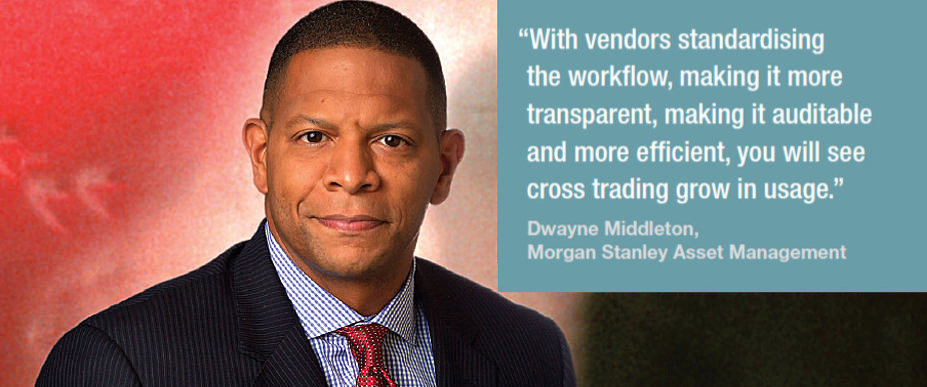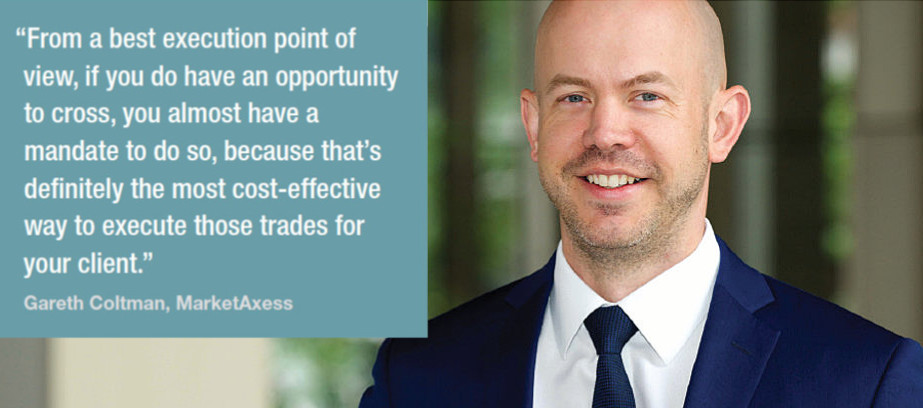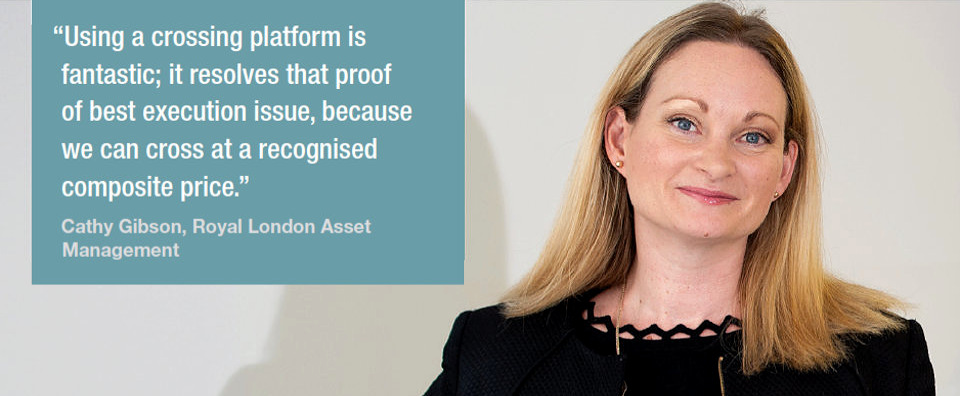The best ways to cross‑trade
Crossing trades between funds is operationally complex but rewarding for investors and asset managers; using platforms to standardise the process reduces that complexity. Dan Barnes reports.
When an asset manager’s fund is buying what another one of its funds is selling, crossing that trade internally can save the investment firm the transaction costs of an external trade, which is great for both funds’ investors. The bid/ask for a generic corporate bond might be three to five basis points, which if executed at the mid-point saves that amount of transaction cost for both clients.

“With spreads where they are within fixed income as a whole, any way you can mitigate transaction costs, is a big value-add to client portfolios,” says Dwayne Middleton, head of US Fixed Income Trading at Morgan Stanley Asset Management, which handles US$482 billion in assets under management (AUM). “So for the clients that are eligible to do a cross trade, I think that’s where the focus is increasing.”
According to the blue paper ‘Winning under pressure’ published by Oliver Wyman and Morgan Stanley Research in March 2018, absolute costs for asset managers increased by 8% in 2017, and the future industry-wide growth of 10% from 2017 to 2020 is expected to be offset by 13% through pressure on fees and increased passive investing. That will pile pressure on the industry’s cost structure.
Cross trades might reduce costs but they can be challenging to manage for clients. Firstly they require considerable co-ordination between funds; secondly they need expertise on the trading desk to support execution and to evidence best execution. Finally, the settlement process between the legal entities must be managed. Getting those pieces right can be incredibly valuable for a buy-side firm.

“From a best execution point of view, if you do have an opportunity to cross, you almost have a mandate to do so, because that’s definitely the most cost-effective way to execute those trades for your client,” says Gareth Coltman, head of European Product Management at market operator MarketAxess. “If you go to market with this, you are going to have to pay the spread in order to execute this trade. So there is a really strong mandate to make sure that buy-side firms can do this for clients, as part of their best execution process.”
Permission and process
Ascertaining when a trade can be crossed is the starting point. The dealing desk and portfolio management function must ensure that asset owners’ wishes are paramount when engaging on their behalf.
“We are on the Aladdin system, which enables our investment teams to flag that particular orders are eligible for a cross trade. That doesn’t automatically mean we can do the cross trade because it depends on the types of accounts in the orders,” says Middleton, whose firm is currently evaluating third-party crossing platforms.

Joeri Wouters, senior fixed income dealer at KBC Asset Management, which manages over €100 billion in client assets says, “We can filter our list of unexecuted bonds by ISIN and required settlement date for example, making it easy to spot cross or block opportunities. In addition, there is communication between the dealing desk and the portfolio managers on heavy trading days in order to maximise the chance of identifying potential crosses.”
The regulatory environment and client mandates play a big part in determining whether funds can use cross trading to good effect. Transactions that are ‘affiliated’ e.g. between parts of the same fund management body, are prohibited under Section 17(A) of the Investment Company Act.
However, Rule 17A-7 permits affiliated transactions for equity and bond trading where only a transfer fee is paid, the exchange is delivery vs payment (DVP) and following several advisory letters from the Securities Exchange Commission, where an independent price is sought that supports the fiduciary duty to both clients.
“Certain clients are never eligible to perform a cross trade and 40 ACT funds are subject to Rule 17A-7, which we also apply to our other clients,” says Middleton. “We work with our compliance colleagues to ensure that each trade, and each client within a particular order is eligible to perform the cross.”
In Europe, the picture is complicated by 2018’s MiFID II rules. These can impose obligations on firms that provide an exchange of legal ownership, even if that takes place internally. Its net was cast wide as a consequence of MiFID I’s failure to catch broker crossing networks (BCNs) within its wording in 2007. They were able to function as entities with virtually no compliance obligations for 11 years as a result. Since 3 January 2018 trading venues are either classified as multi-lateral trading facilities for non-discretionary facilitation of client trades, systematic internalisers for proprietary trading against clients or organised trading facilities (OTFs) for discretionary facilitation of client trades.
Cathy Gibson, head of trading at Royal London Asset Management (RLAM) says, “Under MiFID II if we internally we cross the trades between one fund and another fund with a change in beneficial owner, we would have to register as an OTF, and so we cross trades externally.”
RLAM which has £113 billion in AUM, is assessing third-party platforms to support external crossing at present.
However, depending upon the type of institution, typically based upon the structure of fund management, some have received confirmation from regulators that they are able to cross trades internally without OTF registration.
“We were already crossing orders internally before MiFID II hit the market and we are still able to operate as we did before, crossing internally not externally,” says Wouters. “This means we do not have to use a platform, and we can still cross at one level without paying any fees, which is beneficial for our clients. Our legal team did a thorough check on the procedure in place and validated its robustness, also in a MiFID II environment.”
Price formation and formality
The development of platforms to support crossing could potentially formalise some areas of trading that currently exist either in a grey area or lack formality. Most pressing of these is the use of a reference price to support either Rule 17A-7 or MiFID II’s best execution obligation. Pricing is controversial in markets where assets may trade infrequently and/or no central price tape exists.
“What should clients expect from a reference price?” asks Coltman. “You could directly look at the run data, and maybe take an average, maybe that’s your reference price. Some of our competitors offer that as their reference price. The problem is not all of that data is necessarily of a high quality, and accurate. I think clients should be thinking about the sources of data that go into a reference price and their quality.”
Wouters notes that there are a number of conditions that have to be fulfilled in order to support best execution for both portfolios including the execution benchmark.
“Apart from the cross having to be opportune for both sides, the execution benchmark has to be unbiased between the buyer and the seller,” he says. “The benchmark level we use is generally the end-of-day mid-close price. For more illiquid securities, we will check reference prices with market participants active on that security to identify a realistic mid-level. Both these levels are unknown and unbiased at the time the cross opportunity is identified at our desk.”
Middleton says, “Our current process – for clients that are eligible to use cross trades – is to capture a two-sided market from three dealers, taking the best bid and the cheapest offer and then coming up with a mid-point execution model to execute the internal cross trade.”
Standardisation
Several trading venue providers, including interdealer brokers (IDBs), are currently offering crossing functionality as an external service. Although this will make the fee for transfer higher than an internal-only model, it also provides several advantages.
“We are in the diligence process with a vendor platform that creates a more standardised process by making the cross price level more transparent, building the valuation point to effect cross trades in a way that is auditable and efficient,” says Middleton.
In Europe it helps asset managers to sidestep the issue of registering as a platform and creates more solid support for best execution reports.

“Using a crossing platform is fantastic; it resolves that proof of best execution issue, because we can cross at a recognised composite price,” says Gibson. “If we use an IDB composite price for example and execute at mid, that takes out the bid/offer element of the trading cost, so it’s hugely beneficial for our clients, and we will plan to maximise our use of cross trades where we can.”
MarketAxess claims to have 35 clients as regular users on its crossing platform in Europe, and in April began providing emerging markets and US dollar pricing on top of existing Euro products.
There are challenges with current offerings. Where asset managers use crossing for a wide range of debt instruments, platforms are often restricted to the corporate bond market. In addition, fee structures are still debated amongst the buy side where a fixed fee for each side, regardless of the bonds’ duration, makes some trades more expensive than others.
Nevertheless, cost pressures mean that any provider offering a simpler route to low-cost crossing will find it has support amongst the wider buy side.
“I think with vendors standardising the workflow, making it more transparent, making it auditable and more efficient, you will see cross trading grow in usage,” says Middleton. “When on-boarding a new eligible client, that may become a standard question, as to whether the client would like the ability to do cross trades where we can save on transaction costs.”
©Markets Media Europe 2025


























